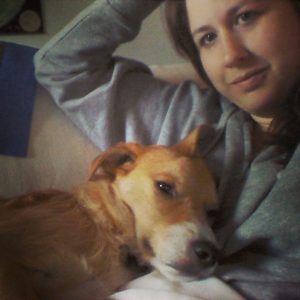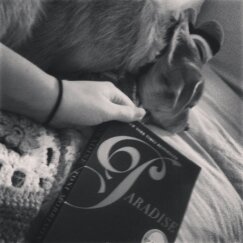
I always had pets growing up, but I didn’t have a ‘fur baby’ until Buddy. Actually, I couldn’t even understand why people would call pets, fur babies. Of course, a baby of your own is something more sacred than a pet dog or cat, but with my first pet as an adult, I learned just how much I could love an animal.
Buddy became a part of our family on my first wedding anniversary. On that sunny summer day, my husband and I stopped in the parking lot of a tractor supply store to meet dogs that were up for adoption. We fell in love with a nine month old golden colored terrier-mutt with white paws, a sweet black nose, and a mane of long wiry hair on his shoulders

With Buddy we experienced several of the firsts of parenthood: feeding, baths, blowouts (a long and smelly story) and all the stuff of daily life. I was familiar with training dogs as my family always had some in our menagerie, and we volunteered weekly at the local Humane Association. Buddy’s foster mother had already taught him more than the basics, but we continued beyond the tricks and tried to make him a polite dog we could be proud of.
In the course of a few months, a few incidents happened that would change our family forever. Although sweet and energetic, playful and fun, our fur baby was ultimately an animal, like any pet. One day he was attacked by another dog, and I truly believe he lost some innocence that day. Our lives continued as normal, but a few times, in situations where food was involved, or small children, our Buddy occasionally lunged, and snapped.
As a pet owner, we made so many excuses for our fur baby, and convinced ourselves that each incident was isolated. But, when he snapped at the child of our friend, we were shocked, embarrassed, and scared. Months later, he lunged at a small child again, this time nipping, and drawing a speck of blood.This time, his stress was easy to explain, yet less easy to forgive. Stress was everywhere that day for pet and owner alike; we were preparing to move cross country with an infant the next morning. All of our things were packed and people had been going in and out of the house cleaning and loading a moving truck.
A million options ran through our head, but we had a deadline to move in the morning, so we put off any decisions. A month later, when a friend came to visit, he pat Buddy on the head. Our dog lunged and barked again. Suddenly, thoughts and questions I had set aside raced through my head. The previous incidents could not be ignored. What would it be like when Linnea started to crawl and climb? Would it be safe to have her little friends over? Were we equipped to handle the situation? We looked in to all of our options.

The shelter downriver wouldn’t take him because of the bite (as is common procedure, dogs who have bitten are often euthenized), but my husband found a shelter in the city of Detroit that was willing to do an evaluation and potentially take him for adoption. We spent the week preparing knowing that it was the right choice, but it was still excruciating to have him leave our family.
We didn’t tell anyone about the first incident because I thought that we as owners could have prevented it. The second time I didn’t want to hear criticism, or admit defeat. But, doing nothing, or lying to the shelter was not an option. It would be like playing Russian Roulette with his future. Buddy is no longer a part of our family, and that is one of the hardest decisions I have ever made. Now, I feel that I have a mission, to help prevent other families from going through a similar experience.
Each person only has control over their own situation. If you have a dog, get him/her fully trained. If you have a child, teach him/her to be polite with your own, and other pets. If you are bringing home a new baby, research the best way to begin a long and safe relationship.
What you can do to keep your child safe:
Teach the proper way to behave around dogs
- Approach- ask the owner if it is OK, approach slowly and calmly
- Greet- with a calm quiet voice. Let the animal smell you
- Pet-gently on shoulders and back, avoid face, back side, feet and tail avoid grabbing or pulling. Use your discretion about when to allow your child near a strange dog– it is OK to say no.
Leave dogs alone when
- They are eating
- Playing with a toy (i.e. don’t take a toy from their mouth)
- Sleeping
Finally, some advice on what to do from Veterinarian, Kevin KickerDVM:
When greeting a dog it is best to have a hand out with the palm down and your body turned side face. Squatting or staying low is best and applicable to even the shortest of small children as they are more likely to approach smaller dogs (large dogs generally intimidate kids). Finally, even with owner permission, a lot of dogs don’t want to be pet by a stranger. Every situation should be assessed for nervous, anxious, or potentially aggressive body language and if there is any indication that the child, pet, or owner is apprehensive then contact shouldn’t be made.
Please follow these guidelines. It would be so sad for someone to say goodbye to their ‘fur baby’ due to a biting situation, but it is much more tragic for a child who is attacked.











